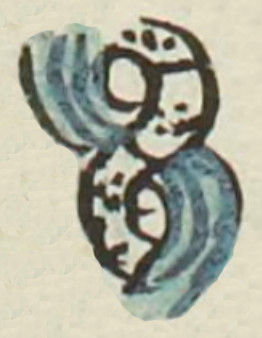Tlachinol (MH545r)
This black-line drawing of the simplex glyph for the personal name Tlachinol (“Scorched Earth,” attested here as a man’s name) shows the diphrasis that is a metaphor for war or catastrophe, teoatl tlachinolli, flood and conflagration or scorched earth. The land part is segmented into cultivated parcels, with dots showing the seeds. This is entwined with the flowing water, which has black lines of current overpainted with a turquoise blue water color. The flame part of tlachinolli, also translated as conflagration, is not present.
Stephanie Wood
It is interesting that the name only refers to the fire part of the diphrasis that is pictured in the glyph. Another Tlachinol glyph in the Matrícula de Huexotzinco shows the land part painted red (probably pointing to fire), and the water part left unpainted. A third one shows a wider stream of water, with flames coming off the side. That one does not involve anything twisted.
Stephanie Wood
aloso tlachinol
Alonso Tlachinol
Stephanie Wood
1560
Jeff Haskett-Wood
fire, flood, metáforas, difrasismo, water, agua, tlachinolli, tierra quemada, scorched earth

tlachinol(li), conflagration, https://nahuatl.wired-humanities.org/content/tlachinolli
James Lockhart (The Nahuas, 1992, 120) refers to the name Yaotlachinol, witnessed in a census from the Cuernavaca region (1535–45), calling it as "The Scorching of War."
La Tierra Quemada
Stephanie Wood
Matrícula de Huexotzinco, folio 545r, https://www.loc.gov/resource/gdcwdl.wdl_15282/?sp=169&st=image
This manuscript is hosted by the Library of Congress and the World Digital Library; used here with the Creative Commons, “Attribution-NonCommercial-ShareAlike 3.0 License” (CC-BY-NC-SAq 3.0).








